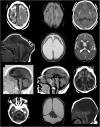Congenital Zika Virus Infection: a Review with Emphasis on the Spectrum of Brain Abnormalities
- PMID: 32880775
- PMCID: PMC7468090
- DOI: 10.1007/s11910-020-01072-0
Congenital Zika Virus Infection: a Review with Emphasis on the Spectrum of Brain Abnormalities
Abstract
Purpose of review: In 2016, the World Health Organization declared the Zika virus (ZIKV) outbreak a Public Health Emergency of International Concern following a cluster of associated neurological disorders and neonatal malformations. Our aim is to review the clinical and neuroimaging findings seen in congenital Zika syndrome.
Recent findings: ZIKV injures neural progenitor cells in the hippocampus, a brain region important for learning, memory, cognition, and emotion/stress response. Positron emission tomography has revealed global neuroinflammation in ZIKV infection in animal models. Congenital Zika syndrome is associated with a spectrum of brain abnormalities, including microcephaly, parenchymal calcifications, malformations of cortical development and defective neuronal migration, corpus callosum abnormalities, ventriculomegaly, and brainstem and cerebellar abnormalities.
Keywords: Microcephaly; Neuroimaging; Zika virus; Zika virus infection.
Conflict of interest statement
Leão VHP, Aragão MM, Pinho RS, Hazin AN, Paciorkowski AR, Penalva de Oliveira AC, and Masruha, MR each declare no potential conflicts of interest.
Figures

References
Publication types
MeSH terms
LinkOut - more resources
Full Text Sources
Medical
Research Materials

